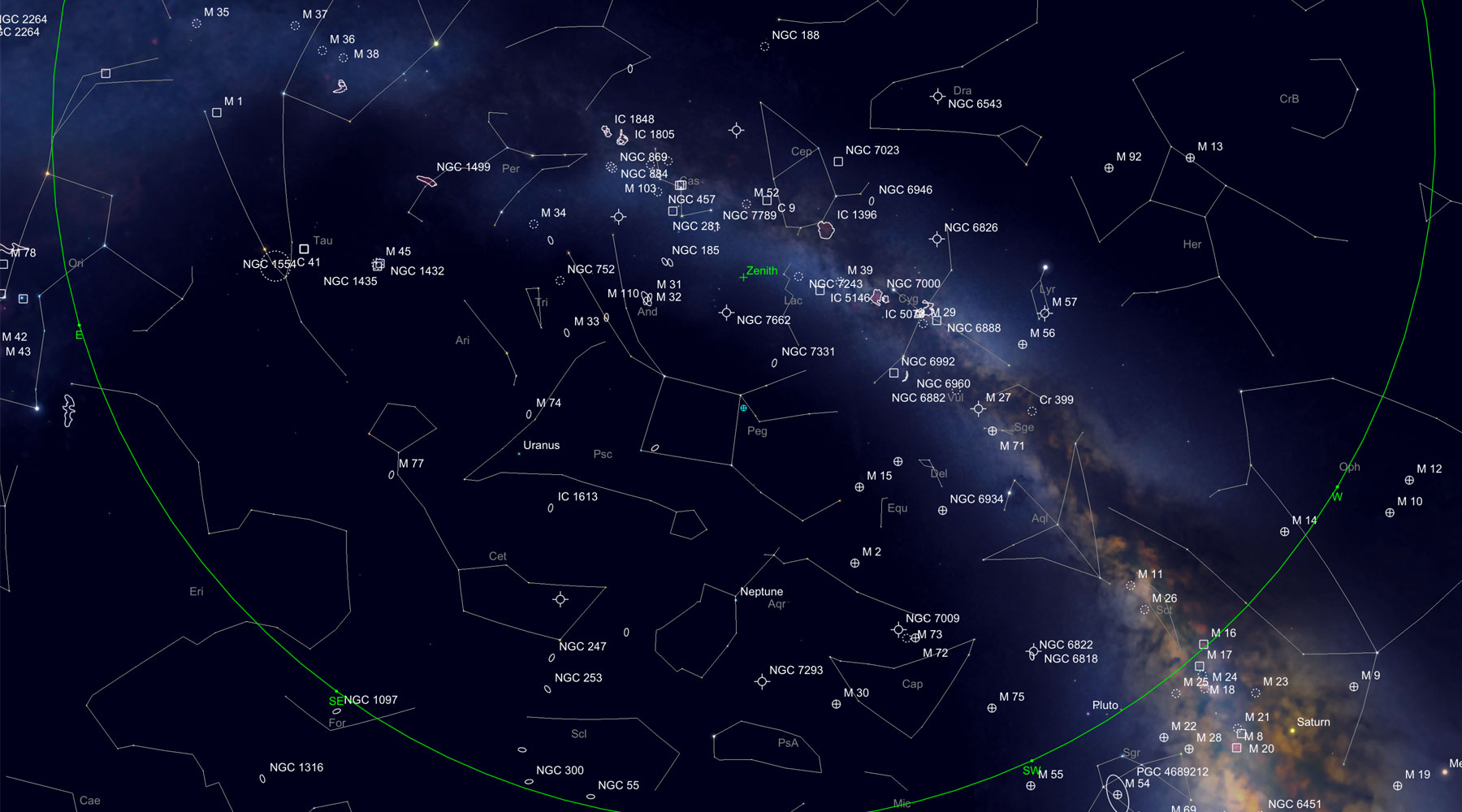Deep Sky Autumn Observations October - Mid-December 2017
Conditions | Observation Overview | List of Observed Sky Objects | References
Between October and mid-December 2017, I did simple "deep-sky autumn observations", mostly with binoculars, which might be of interest to other beginners and are therefore described here.
Conditions
Sky Region and Objects
My observations ranged between the coming Orion in the East to Hercules in the West. I mostly "hunted" for objects that can be observed with binoculars.
Overview Map
The following map shows approximately the sky area that I primarily browsed during my observations:
Click the map for a larger version - it opens in a new window (Image Courtesy of SkySafari Astronomy, www.simulationcurriculum.com)
Observation Time
Observations started early and the sooner, the later it became in the year. At the beginning of November, I also observed after midnight with my binoculars.
Observation Location
All observations were conducted in Mühlhausen/Kraichgau (Germany):
- Coordinates: 49° 15′ N , 8° 43′ E
- Coordinates (dec.): 49,25° N, 8,72° E
Devices Used
- Sky-Watcher Heritage 100P
- Leica Trinovid 10 x 25 binoculars
- TS 10 x 60 binoculars
General Conditions
In general, the sky above Mühlhausen/Kraichgau is "light-polluted" and does not invite you to search for deep sky objects. This is certainly one of the reasons why I found some of the deep sky objects that I wanted to observe only sometimes or not at all.
Observation Overview
| Date 2017 |
Observed Objects | Details, Remarks | Further Observations and Remarks | Devices Used | Eyepieces Used |
| October | GC: NGC 884/869 (Perseus Double Cluster) P: Cr 399 (Coat Hanger) |
Several observations, both objects seen well | Only binocular observations (comparison of the new night glass with the old compact binoculars) | LT and TS binoculars | |
| Nov 4 | GE: M42/43 (Orion Nebula) OS: Mel 25 (Hyades) |
M 42/43 seen in binoculars; quite faint due to almost Full Moon (midnight
until about 1 o' clock), 2 bright spots (stars and presumably the Trapezium)
glow in the nebula Mel 25 seen well (after midnight) |
Only binocular observations (comparison of the new night glass with the old compact binoculars) | LT and TS binoculars | |
| Nov 13 | G: M 31 (Andromeda Galaxy) GC: M 13 (Hercules Globular Cluster) OC: NGC 884/869, Mel 20 (Perseus Cluster), M 45 (Pleiades), Mel 25, M 34, M 39, M 11 (Wild Duck Cluster) P: Cr 399, St 2 (Muscle Man) |
NGC 884/869 with "ring" (at its end is supposed to be St 2) St 2 (muscle man) located at the "ring" of the double cluster: shape not recognized as such, but seen stars... Cr 399 found via Albireo M 39 at Deneb, at the upper left end of a transverse Ypsilon shape (TS) M 11 Wild Duck Cluster, probably not seen at the bottom of the swan |
100P: Mel 20, NGC 884/869, M 34, M 39 | LT and TS binoculars, Heritage 100P | Not documented |
| Dec 12 | GE: M42/43 OS: M 45, Mel 25, M 35 |
M 42/43, M 35, M45, Mel 25 seen well, M 35 not so good... | LT and TS binoculars |
Bold: First observation during this observation period; G = galaxy, OC = open star cluster, GC = globular star cluster, P = star pattern
List of Observed Sky Objects
Object details can be obtained via the links to the relevant deep sky objects.
DSO Details |
Name | Constellation | Type | Bino* | 100P | Remarks |
| M 13 | Hercules Cluster | Hercules | GC | yes | Seen well in binoculars | |
| M 39 | Cygnus | OC | yes | yes | View in telescope not impressing | |
| Cr 399 | Coat Hanger | Vulpecula | P | yes | Seen well in binoculars, found via Albireo | |
| M 11 | Wild Duck Cluster | Scutum | OC | yes | Probably not seen... | |
| M 31 | Andromeda Galaxy | Andromeda | G | yes | A glow in binoculars | |
| M 34 | Perseus | OC | yes | yes | Primarily an object for binoculars | |
| NGC 884/869 | Perseus Double Cluster | Perseus | OC | yes | yes | Seen well in binoculars, with "oval" of stars |
| Mel 20 | Alpha Persei Cluster (Mirfak) | Perseus | OC | yes | yes | Seen well in binoculars, very extended |
| Mel 25 | Hyades | Taurus | OC | yes | Seen well in binoculars, very extended | |
| M 45 | Pleiades | Taurus | OC | yes | Seen well in binoculars | |
| M 42/43 | Orion Nebula | Orion | GE | yes | M 42/43 seen in binoculars; very faint because it was nearly Full Moon (midnight until about 1'clock), 2 bright spots (stars, probably the Trapezium) glowed in the nebula | |
| M 35 | Gemini | G | yes | M 35 seen only faintly |
*) LT and TS binoculars; G = galaxy, OC = open star cluster, GC = globular star cluster, GE = galactic emission nebula, P = star pattern
References
Books
- Michael Feiler & Philip Novak (2023). Deep Sky Reiseatlas (5. Auflage), Oculum Verlag (ISBN 978-3-949370-04-5)
www.oculum-verlag.de/detailview?no=608 - Ronald Stoyan (2021). Deep Sky Reiseführer (6. Auflage), Oculum Verlag (ISBN 978-3-938469-72-9)
www.oculum-verlag.de/detailview?no=603 - Erich Karkoschka (2022). Atlas für Himmelsbeobachter, Kosmos Verlag (EAN: 9783440173602)
www.kosmos.de/de/atlas-fur-himmelsbeobachter_1074889_9783440173602
On this Website
- Overview of Observations
- DSO List (Collected from Books)
- Sky-Watcher Heritage 100P Information (4" Dobson)
- My Binoculars
| 28.04.2024 |
